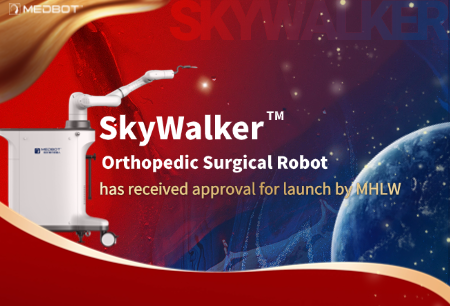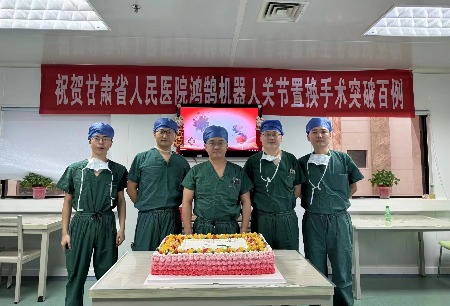Shandong Province, China - The Honghu Orthopedic Surgical Robot (hereinafter referred to as "Honghu1"), developed independently by MicroPort NaviBot (Suzhou) Co., Ltd., a subsidiary of Shanghai MicroPort MedBot (Group) Co., Ltd. (hereinafter referred to as "MicroPort® MedBot®"), have successfully completed its first robot-assisted TKA recently under the leadership of Lixin Kang, chief physician of Tengzhou Central People's Hospital in southern Shandong Province. This not only breaks new ground in the robot-assisted knee arthroplasty in southern Shandong Province, but also creates a precedent for the domestic robot to perform TKA in the region. Up to now, Lixin Kang, a director of Tengzhou Central People's Hospital, has completed 4 TKAs with his team by using the Honghu Orthopedic Surgical Robot. Honghu is in full swing to promote orthopedic surgery into the "digital orthopedic" era, and bring good news to a wider range of bone disease patients in China.
There were 2 patients in this surgery, one of whom was a 65-year-old woman with pain in both knee joints for more than 10 years. She had a right knee flexion varus deformity with approximately 20° varus, patellar grind test of right knee (+), and right knee mobility: 0° - 10° - 100°. Another patient was a 62-year-old female with right knee pain for 2 years. The medial joint space of the right knee and the tenderness of the patella were obvious, with patellar grind test (+) and right knee mobility: 0°-10°-110°. After a comprehensive evaluation, Director Lixin Kang's team decided to perform robot-assisted TKA.
Before the surgery, Director Lixin Kang's team conducted 3D reconstruction of the knee joint CT image through Honghu preoperative planning software. Honghu can quickly reconstruct the patients' anatomical models of the joints through intelligent analysis of 3D CT image data of patients' lower limbs, and formulate personalized surgical solutions. During the surgery, the robot guided the robot arm registration and bone registration, precisely navigated the intraoperative prosthesis placement and osteotomy position, assisted doctors to accurately complete the tibia and femur osteotomy according to the preoperative surgical plan, and successfully installed the prosthesis. The whole process was smooth and efficient. The full-length film of the lower limbs re-examined after the surgery showed a very accurate restoration of the mechanical axis of the lower limbs. They got out of bed and walked on the second day after the surgery and was discharged from the hospital on the third day. Both were satisfied with the speed of recovery.
For a long time, the demand for orthopedic treatment in our country can not be underestimated. According to the Chinese Yearbook of Surgery, there are up to 20 million orthopedic trauma cases in China every year, 79.35% of which require surgical treatment.
The combination of artificial intelligence and orthopedics is developing on the high-speed track of all-round intelligence. In addition to assisting diagnosis and other technologies that are also applied to other medical fields, orthopedics surgery robot is one of the important applications of orthopedics +AI, and it is also one of the applications that most demonstrate technical strength.
1 The registered trademark of HongHu is named “Skywalker” in abroad , which is in the process of application in USA, completed registration in EU and other countries and regions.
-
 2024-09-29SkyWalkerTM has received approval for launch by MHLW, achieving comprehensive coverage in key markets!
2024-09-29SkyWalkerTM has received approval for launch by MHLW, achieving comprehensive coverage in key markets! -
 2024-04-16SkyWalker® Orthopedic Surgical Robot global surgical volume exceeds a thousand cases, domestic high-end medical equipment clinical application stepping towards global
2024-04-16SkyWalker® Orthopedic Surgical Robot global surgical volume exceeds a thousand cases, domestic high-end medical equipment clinical application stepping towards global -
 2024-01-18Gansu Provincial People's Hospital has completed over 100 SkyWalker™-assisted total knee arthroplasty surgeries
2024-01-18Gansu Provincial People's Hospital has completed over 100 SkyWalker™-assisted total knee arthroplasty surgeries






 Hu ICP Bei No. 20013662 HGWA Bei No. 31011502015178
Hu ICP Bei No. 20013662 HGWA Bei No. 31011502015178 " are registered trademarks of Shanghai MicroPort Medical (Group) Co., Ltd.” . They have been authorized to be used by Shanghai Microport Medbot (Group) Co., Ltd., and no other party shall use such trademarks without prior written permission thereof.
" are registered trademarks of Shanghai MicroPort Medical (Group) Co., Ltd.” . They have been authorized to be used by Shanghai Microport Medbot (Group) Co., Ltd., and no other party shall use such trademarks without prior written permission thereof.
